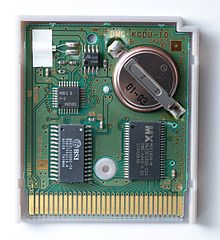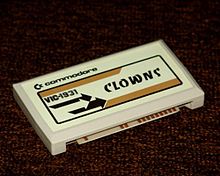ROM cartridge
![]()
The articles Module (computer games) and Plug-in module overlap thematically. Information that you are looking for here can also be found in the other article.
You are welcome to participate in the relevant redundancy discussion or to help directly to merge the articles or to better distinguish them from each other (→ Instructions).
A cartridge is a storage medium that was used in game consoles and home computers as a data carrier for game software. In this context, it is also referred to as a game (e)module. With the beginning of the Fairchild Channel F and Atari 2600 platforms, it was first used almost universally, but in the 21st century it was largely replaced by optical storage and memory cards. After that, modules were mostly used on consoles only as memory cards for saving game saves, until they became obsolete there due to the use of memory located inside the console.
The data (program, graphics and sound) are stored on electronic devices ROMs or PROMs. EEPROMs are used to store a game state on most later modules.
The housing is made of plastic; inside there is a printed circuit board on which, among other electronic components, the ROMs are located. The conductive tracks connected to the components end in gold-plated contacts that protrude from the bottom of the module. By inserting the module into the card slot of the game console (which should be done when the device is switched off), the microprocessor has access to the external program data.
Special modules are the Double-Ender from Xonox, which has contacts on the top as well as on the bottom side and thus accommodates two game modules in only one housing.

Game modules

Printed circuit board of a Game Boy game with battery-powered memory

Module for the Commodore VC 20
Advantages
- Low (hardly noticeable) loading times compared to optical and magnetic storage media, as no mechanics are required to read out the data.
- From the manufacturer's point of view, it is advantageous that copying a module is extremely time-consuming and is therefore practically not practiced. However, with special equipment it is easily possible to read out the mostly copyrighted contents of a module and store them as binary data on other media such as a hard disk or a flash module.
- Modules are compact, robust and insensitive to shocks as they contain no moving parts (especially important for portable game consoles).
- Modules can contain add-on hardware that allows for things beyond the console's originally intended capabilities, such as a graphics chip to create special effects. A prominent example is the Super FX chip that was used in some SNES game modules.
- Modules are more energy efficient than optical storage media.
- Modules are quieter than optical storage media because no moving parts are required to read the data.
Cons
- High production costs compared to optical storage media such as CD-ROM and DVD.
- Due to the comparatively low memory capacity, hardly any video and audio sequences can be integrated into the games.
- Game states that are stored battery-supported on the module are lost when the battery is empty. This can be replaced manually.
- There are no devices available for end users to make backup copies of modules that can be used again as a module normally. With special hardware, backup copies can be written to other media such as flash memory or hard disk. ROMs on hard disk can be emulated on computers with an emulator.
Search within the encyclopedia